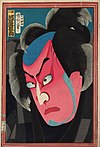Portal:Japan/Selected biography/12
Toyohara Kunichika was a Japanese woodblock print artist. Talented as a child, at about thirteen he became a student of Tokyo's then-leading print maker, Utagawa Kunisada. His deep appreciation and knowledge of kabuki drama led to his production primarily of ukiyo-e actor-prints, which are woodblock prints of kabuki actors and scenes from popular plays of the time. An alcoholic and womanizer, Kunichika also portrayed women deemed beautiful (bijinga), contemporary social life, and a few landscapes and historical scenes. He worked successfully in the Edo era, and carried those traditions into the Meiji era. To his contemporaries and now to some modern art historians, this has been seen as a significant achievement during a transitional period of great social and political change in Japan's history. The artist who became known as Toyohara Kunichika was born Ōshima Yasohachi on June 5, 1835, in the Kyōbashi district, a merchant and artisan area of Edo (present-day Tokyo). His father, Ōshima Kyujū, was the proprietor of a sentō (public bathhouse), the Ōshūya.

